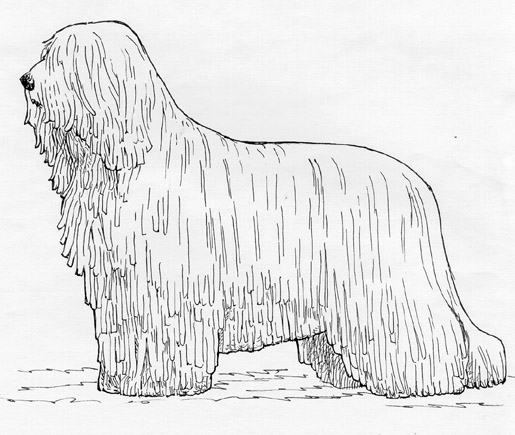Komondor
Guardian Dog Group
The goals and purposes of this breed standard include: to furnish guidelines for breeders who wish to maintain the quality of their breed and to improve it; to advance this breed to a state of similarity throughout the world; and to act as a guide for judges.
Breeders and judges have the responsibility to avoid any conditions or exaggerations that are detrimental to the health, welfare, essence and soundness of this breed, and must take the responsibility to see that these are not perpetuated.
Any departure from the following should be considered a fault, and the seriousness with which the fault should be regarded should be in exact proportion to its degree and its effect upon the health and welfare of the dog and on the dogs ability to perform its traditional work.
History
A native of Hungary, the Komondor is the largest of the Hungarian herding breeds. They are thought to be of Asian origin possibly descended from the Owtcharkas, having been developed from dogs brought to Hungary by the Magyars in the 10th Century.
The Komondor was recognized by the United Kennel Club in 1983.
General Appearance
General appearance is one of imposing strength, courageous demeanor and pleasing conformation. The Komondor is a big muscular dog with plenty of bone and substance, covered with an unusual long, dense, corded ivory colored coat. The breed is capable of living the majority of the year in the open, without protection against strange dogs and beasts of prey.
Characteristics
The Komondor, being naturally wary of strangers, makes an excellent house guard dog. They are devoted to their master and will defend him against attack by any stranger. This trait makes it advisable that the dog only be used as a herd/flock guardian/protector, not for driving. When mature, the breed is an earnest, courageous, very faithful herd/flock guardian. While a puppy, the Komondor is playful.
Head
The thickly coated head is broad but should appear in proportion with the size of the body.
SKULL
Domed, with well developed brows. There is a well developed, but not steep, stop.
MUZZLE
The powerful muzzle is slightly shorter in length than the skull. The bridge of the nose is straight. The jaws are very strong. The lips are black and close fitting.
TEETH
A full complement of strong, white teeth meet in a scissors bite.
Serious Fault: Any missing teeth.
Disqualifications: Overshot, undershot or wry bites.
EYES
The medium size, almond shaped eyes are dark brown in color and horizontally set. They have black, tight fitting rims.
Fault: Light-colored eyes.
Disqualifications: Entropion or ectropion.
NOSE
The nose is wide blunt at the end. It is black in color.
EARS
The medium set, hanging ears are V or U shaped. They are devoid of erectile power.
Faults: Ears that move forward toward an erect position.
Disqualification: Prick ears.
Neck
Rather short and very well muscled. Carried nearly horizontal with the back when the dog is relaxed.
Fault: Any dewlap.
Forequarters
The shoulder slopes moderately.
FORELEGS
The straight, well-boned forelegs are muscular and the joints are large. The legs are like vertical columns from any angle. The limbs are firmly connected to the body.
Fault: Loose elbows.
Body
Body shape is slightly rectangular, the length being only slightly longer than the height, measured at the withers. The chest is broad and deep, the deepest point of the brisket being half the height at the withers. The back is short, broad and muscular. The loin is of medium length, leading into a broad, slightly sloping croup. There is a moderate tuck up.
Hindquarters
Moderately angulated to match the forequarter.
HIND LEGS
Broad and well muscled. Very large upper thighs. Dewclaws should be removed.
Feet
The strong, rather large feet have close, well-arched toes and thick pads that are grey. The nails are black or grey.
Tail
Low set and pendant, with a slight bend in the tip. The tail should reach to the hock. It is never carried above the level of the back.
Coat
Long, dense and double, with a coarse outer coat and finer undercoat. The unique character of the coat is determined by the relationship between the outer coat and the undercoat. The coat must naturally tend to cord or matt. The coat is longest on the croup, the loin and the upper thighs. It is a little shorter on the back, sides of chest and shoulders. It is medium length on the head, neck, ears and limbs. Length of coat corresponds to age and a younger dog is not to be penalized for a shorter coat. A combed coat is not desirable, nor is a coat that has been completely neglected.
Faults: Straight coat. Silky coat.
Disqualification: Coat that fails to cord by the time the dog is two years of age.
Color
The only acceptable coat color is ivory. Skin pigment is preferably slate grey. Pink skin is undesirable.
Disqualification: Any other coat color or combination of colors.
Height
Minimum height for males is 27 inches. For females it is 25 inches. Weight for males ranges from approximately 110 to 130 pounds. Females range from approximately 88 to 110 pounds.
Gait
Light, free and even, with long strides.
Eliminating Faults
(An Eliminating Fault is a Fault serious enough that it eliminates the dog from obtaining any awards in a conformation event.)
Adult dogs under the minimum height requirements.
Disqualifications
(A dog with a Disqualification must not be considered for placement in a conformation event, and must be reported to UKC.)
Unilateral or bilateral cryptorchid.
Viciousness or extreme shyness.
Bobtail.
Entropion or ectropion.
Overshot, undershot or wry bites.
Prick ears.
Any other coat color or combination of colors.
Coat that fails to cord by the time the dog is two years of age.
Albinism.

Looking for a Dog?
Find a dog that will fit your family.
Note: The breeders on this list are not endorsed by UKC.
Revised July 1, 2009
©Copyright 1992, United Kennel Club
